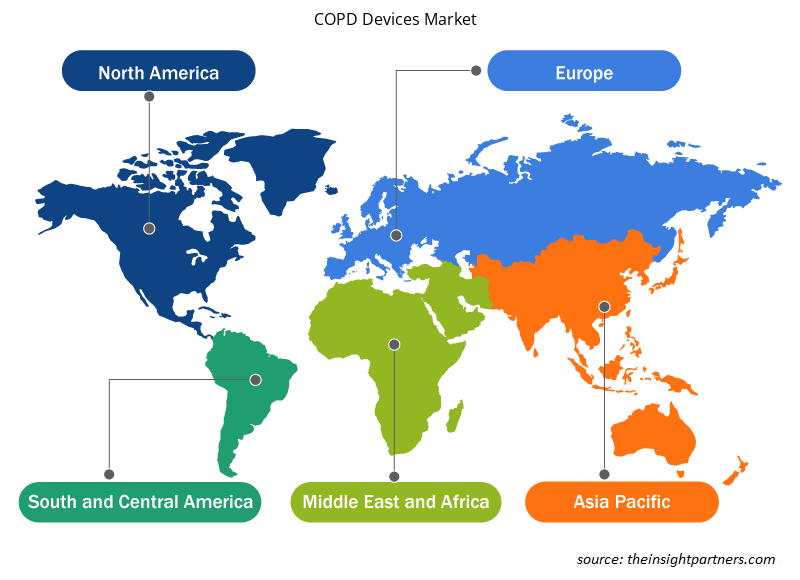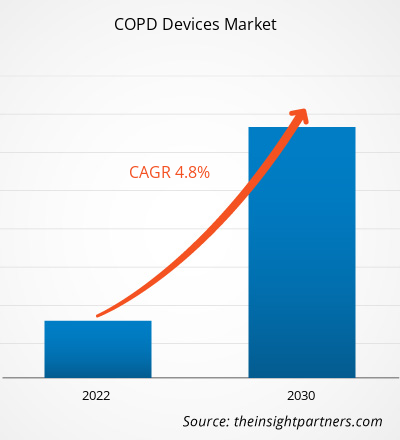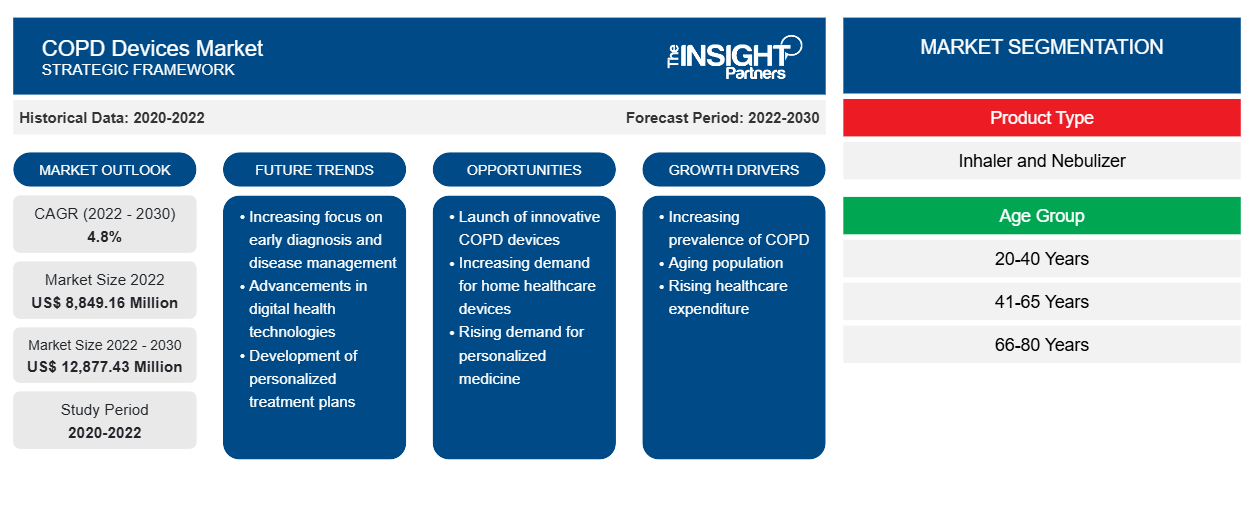[Rapport de recherche] Le marché des dispositifs de traitement de la BPCO devrait passer de 8 849,16 millions USD en 2022 à 12 877,43 millions USD en 2030 ; il devrait enregistrer un TCAC de 4,8 % de 2022 à 2030.
Informations sur le marché et point de vue des analystes :
La BPCO est une maladie chronique qui provoque une inflammation des poumons, endommage les tissus pulmonaires et entraîne un rétrécissement des voies respiratoires, ce qui rend la respiration difficile. Le marché des dispositifs de traitement de la BPCO s'élargit avec l'augmentation des activités de R&D visant à développer des inhalateurs intelligents pour le traitement de la BPCO, l'augmentation du nombre de cas de BPCO et l'augmentation du soutien gouvernemental au traitement de la BPCO. En outre, la disponibilité de produits avancés par les acteurs du marché stimule encore davantage la croissance du marché. Par exemple, en juin 2021, Glenmark Pharma a lancé l'inhalateur de poudre sèche au bromure de tiotropium, utilisé pour traiter la BPCO au Royaume-Uni.
Moteurs de croissance et défis :
La BPCO est une maladie pulmonaire chronique qui provoque une inflammation pulmonaire, entraînant une obstruction du flux d'air dans les poumons. Les symptômes de la BPCO comprennent des difficultés respiratoires, une production de mucus (expectorations), une toux et une respiration sifflante. Elle est généralement causée par une exposition à long terme à des gaz irritants ou à des particules, le plus souvent de la fumée de cigarette . Les personnes souffrant de BPCO courent un risque accru de développer un cancer du poumon, une maladie cardiaque et diverses autres affections. Selon l'American Lung Association, la BPCO est la principale cause de décès aux États-Unis, et plus de 12 millions d'Américains ont été diagnostiqués avec ces maladies en 2022. Selon la même source, environ 8,5 millions d'adultes dans le monde ont reçu un diagnostic de BPCO en 2019-2020. Selon l'Organisation mondiale de la santé (OMS), en 2021, la BPCO était la troisième cause de décès dans le monde. Le taux de mortalité élevé de la BPCO est dû à des exacerbations aiguës, qui entraînent une défaillance des muscles respiratoires des patients, entraînant la perte de la capacité du patient à respirer de manière autonome ; En conséquence, les patients meurent d'une infection systémique et d'une asphyxie. De plus, selon le rapport sur la charge des maladies pulmonaires obstructives (BOLD), en 2020, la mortalité due à la BPCO devrait augmenter dans le monde entier au cours des 40 prochaines années, pour atteindre environ 5,4 millions de décès par an d'ici 2060. La prévalence croissante de la BPCO à l'échelle mondiale alimente la croissance du marché des dispositifs de traitement de la BPCO.
Personnalisez ce rapport en fonction de vos besoins
Vous bénéficierez d'une personnalisation gratuite de n'importe quel rapport, y compris de certaines parties de ce rapport, d'une analyse au niveau des pays, d'un pack de données Excel, ainsi que d'offres et de remises exceptionnelles pour les start-ups et les universités.
-
Obtenez les principales tendances clés du marché de ce rapport.Cet échantillon GRATUIT comprendra une analyse de données, allant des tendances du marché aux estimations et prévisions.
Segmentation et portée du rapport :
Le marché des dispositifs pour la BPCO est segmenté en fonction du type de produit, de la tranche d'âge, du canal de distribution et de la géographie. Le marché des dispositifs pour la BPCO, par type, est segmenté en inhalateur et nébuliseur. Le marché des dispositifs pour la BPCO, par tranche d'âge, est segmenté en 20-40 ans, 41-65 ans, 66-80 ans et 85 ans et plus. Le marché des dispositifs pour la BPCO, par canal de distribution, est segmenté en pharmacies hospitalières, pharmacies de détail et pharmacies en ligne. En fonction de la géographie, le marché des dispositifs pour la BPCO est classé en Amérique du Nord (États-Unis, Canada et Mexique), Europe (Royaume-Uni, Allemagne, France, Italie, Espagne et reste de l'Europe), Asie-Pacifique (Chine, Australie, Japon, Inde, Corée du Sud et reste de l'Asie-Pacifique), Moyen-Orient et Afrique (EAU, Arabie saoudite, Afrique du Sud et reste du Moyen-Orient et de l'Afrique) et Amérique du Sud et centrale (Brésil, Argentine et reste de l'Amérique du Sud et centrale).
Analyse segmentaire : Analysis:
Le marché des dispositifs de traitement de la BPCO, par type de produit, est divisé en inhalateurs et nébuliseurs. En 2022, le segment des inhalateurs détenait une part de marché plus importante et devrait enregistrer un TCAC plus élevé au cours de la période de prévision. Les inhalateurs-doseurs (MDI) et les inhalateurs à poudre sèche (DPI) sont deux principaux types d'inhalateurs utilisés pour traiter la BPCO. Contrairement aux autres inhalateurs qui fournissent une bouffée de médicament, ces inhalateurs contiennent le médicament sous forme de poudre sèche. Le patient doit inspirer rapidement et profondément pour faire pénétrer le médicament dans les poumons. Les inhalateurs à poudre sèche sont des alternatives cliniquement appropriées et rentables. Les inhalateurs-doseurs (MDI) sont des systèmes d'inhalateurs pressurisés portatifs qui fournissent directement de petites doses précises de médicament dans les voies respiratoires d'un patient. Les dispositifs MDI comprennent une valve et un actionneur qui facilitent l'administration constante d'une dose précise de médicament au patient sous forme de particules d'une distribution de taille exacte délivrées via un propulseur. Ces inhalateurs nécessitent des gaz propulseurs dont la pression de vapeur peut être liquéfiée à des températures comprises entre 40 et 70 psi à l'intérieur de la cartouche. Les carburants utilisés dans ces inhalateurs-doseurs pour l'inhalation de médicaments doivent être certifiés par la Food and Drug Administration. Cela doit impliquer la qualité d'inhalation des bonnes pratiques de fabrication (cGMP) actuelles avec des niveaux de pureté élevés.
Analyse régionale :
En fonction de la géographie, le marché des dispositifs de traitement de la BPCO est classé en Amérique du Nord, Europe, Asie-Pacifique, Moyen-Orient et Afrique, et Amérique du Sud et centrale. L'Amérique du Nord est le plus grand contributeur à la croissance du marché mondial des dispositifs de traitement de la BPCO. En outre, l'Asie-Pacifique devrait enregistrer le TCAC le plus élevé sur le marché mondial des dispositifs de traitement de la BPCO au cours de la période de prévision. La croissance future de ce marché est probablement attribuée à la prévalence croissante des troubles respiratoires. En outre, la bronchopneumopathie chronique obstructive (BPCO) est un problème de santé majeur aux États-Unis. La BPCO est causée par l'obstruction du flux d'air des poumons, ce qui peut entraîner une maladie pulmonaire inflammatoire chronique. Le tabagisme est l'une des principales causes de la BPCO aux États-Unis. La préférence croissante pour le tabagisme aux États-Unis stimule la croissance du marché des dispositifs de traitement de la BPCO. Selon les Centers for Disease Control and Prevention (CDC), environ 14,8 millions d'adultes aux États-Unis souffrent de BPCO.
En outre, selon l'Administration for Community Living, les personnes âgées de 65 ans et plus aux États-Unis représentent 54,1 millions de personnes, soit 16 % de la population totale, et ce chiffre devrait atteindre 21,6 % d'ici 2040. Les personnes âgées sont extrêmement sensibles aux maladies respiratoires chroniques. Ainsi, l'augmentation de la population âgée devrait également stimuler la demande d'inhalateurs respiratoires au cours de la période de prévision. En outre, des politiques de remboursement favorables devraient créer plusieurs opportunités de croissance du marché des dispositifs de traitement de la BPCO dans la région.
Aperçu régional du marché des dispositifs de traitement de la BPCO
Les tendances et facteurs régionaux influençant le marché des dispositifs de traitement de la BPCO tout au long de la période de prévision ont été expliqués en détail par les analystes d’Insight Partners. Cette section traite également des segments et de la géographie du marché des dispositifs de traitement de la BPCO en Amérique du Nord, en Europe, en Asie-Pacifique, au Moyen-Orient et en Afrique, ainsi qu’en Amérique du Sud et en Amérique centrale.

- Obtenez les données régionales spécifiques au marché des dispositifs de traitement de la BPCO
Portée du rapport sur le marché des dispositifs de traitement de la BPCO
| Attribut de rapport | Détails |
|---|---|
| Taille du marché en 2022 | 8 849,16 millions de dollars américains |
| Taille du marché d'ici 2030 | 12 877,43 millions de dollars américains |
| Taux de croissance annuel moyen mondial (2022-2030) | 4,8% |
| Données historiques | 2020-2022 |
| Période de prévision | 2022-2030 |
| Segments couverts |
Par type de produit
|
| Régions et pays couverts |
Amérique du Nord
|
| Leaders du marché et profils d'entreprises clés |
|
Densité des acteurs du marché des dispositifs de traitement de la BPCO : comprendre son impact sur la dynamique commerciale
Le marché des dispositifs de traitement de la BPCO connaît une croissance rapide, tirée par la demande croissante des utilisateurs finaux en raison de facteurs tels que l'évolution des préférences des consommateurs, les avancées technologiques et une plus grande sensibilisation aux avantages du produit. À mesure que la demande augmente, les entreprises élargissent leurs offres, innovent pour répondre aux besoins des consommateurs et capitalisent sur les tendances émergentes, ce qui alimente davantage la croissance du marché.
La densité des acteurs du marché fait référence à la répartition des entreprises ou des sociétés opérant sur un marché ou un secteur particulier. Elle indique le nombre de concurrents (acteurs du marché) présents sur un marché donné par rapport à sa taille ou à sa valeur marchande totale.
Les principales entreprises opérant sur le marché des dispositifs de traitement de la BPCO sont :
- AstraZeneca SA
- Beximco Pharmaceuticals Ltd
- Getinge AB
- Boehringer Ingelheim
- GSK Plc
Avis de non-responsabilité : les sociétés répertoriées ci-dessus ne sont pas classées dans un ordre particulier.

- Obtenez un aperçu des principaux acteurs du marché des dispositifs de traitement de la BPCO
Développements de l'industrie et opportunités futures :
Différents plans d’acteurs clés opérant sur le marché des dispositifs de lutte contre la BPCO sont répertoriés ci-dessous :
- En avril 2022, GlaxoSmithKline Pharmaceuticals Limited a lancé Trelegy Ellipta (furoate de fluticasone/umeclidinium/vilanterol) en Inde. Il s'agit de la première trithérapie par inhalateur unique (TITS) pour les patients atteints de BPCO dans le cadre d'un régime à prise unique quotidienne. Le produit a également été approuvé par le Drugs Controller General of India (DCGI) pour la consommation de Trelegy Ellipta comme traitement d'entretien pour prévenir et soulager les symptômes liés à la BPCO chez les patients âgés de 18 ans et plus.
Paysage concurrentiel et entreprises clés :
Parmi les principaux acteurs opérant sur le marché des dispositifs pour la BPCO figurent AstraZeneca PLC, Beximco Pharmaceuticals Ltd, Getinge AB, Boehringer Ingelheim, GSK Plc, Medtronic PLC, Nephron Pharmaceuticals, Novartis AG, Sunovion Pharmaceuticals Inc et Teva Pharmaceuticals. Ces entreprises se concentrent sur l'expansion géographique et le lancement de nouveaux produits pour répondre à la demande croissante des consommateurs dans le monde entier et élargir leur gamme de produits dans des portefeuilles spécialisés. Leur présence mondiale leur permet de servir une large base de clients, facilitant ainsi l'expansion du marché.
- Analyse historique (2 ans), année de base, prévision (7 ans) avec TCAC
- Analyse PEST et SWOT
- Taille du marché Valeur / Volume - Mondial, Régional, Pays
- Industrie et paysage concurrentiel
- Ensemble de données Excel
Rapports récents
Témoignages
Raison d'acheter
- Prise de décision éclairée
- Compréhension de la dynamique du marché
- Analyse concurrentielle
- Connaissances clients
- Prévisions de marché
- Atténuation des risques
- Planification stratégique
- Justification des investissements
- Identification des marchés émergents
- Amélioration des stratégies marketing
- Amélioration de l'efficacité opérationnelle
- Alignement sur les tendances réglementaires























 Obtenez un échantillon gratuit pour - Marché des dispositifs pour la BPCO
Obtenez un échantillon gratuit pour - Marché des dispositifs pour la BPCO